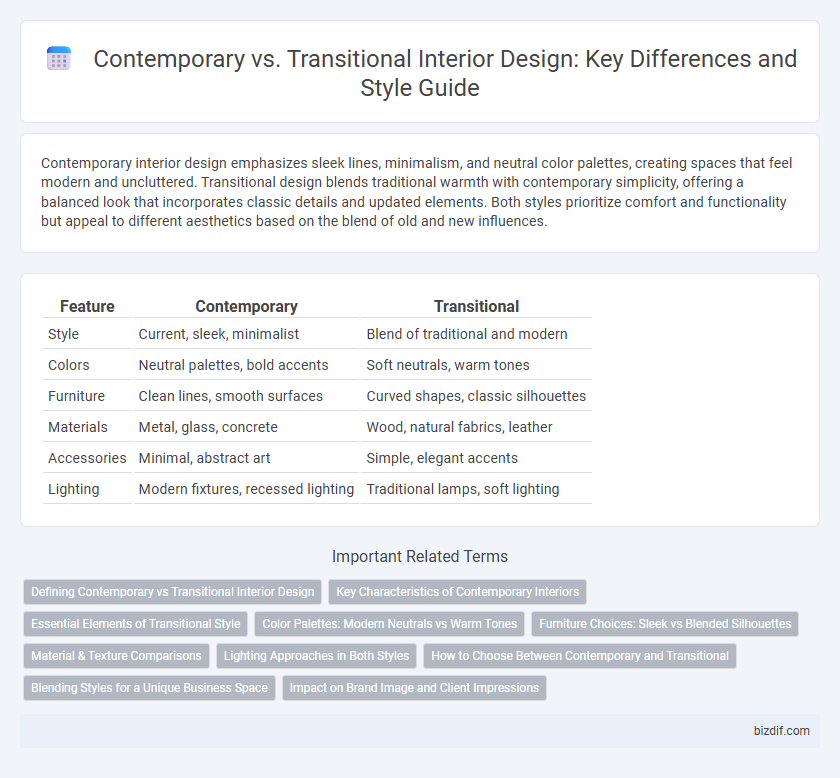Contemporary interior design emphasizes sleek lines, minimalism, and neutral color palettes, creating spaces that feel modern and uncluttered. Transitional design blends traditional warmth with contemporary simplicity, offering a balanced look that incorporates classic details and updated elements. Both styles prioritize comfort and functionality but appeal to different aesthetics based on the blend of old and new influences.
Table of Comparison
| Feature | Contemporary | Transitional |
|---|---|---|
| Style | Current, sleek, minimalist | Blend of traditional and modern |
| Colors | Neutral palettes, bold accents | Soft neutrals, warm tones |
| Furniture | Clean lines, smooth surfaces | Curved shapes, classic silhouettes |
| Materials | Metal, glass, concrete | Wood, natural fabrics, leather |
| Accessories | Minimal, abstract art | Simple, elegant accents |
| Lighting | Modern fixtures, recessed lighting | Traditional lamps, soft lighting |
Defining Contemporary vs Transitional Interior Design
Contemporary interior design features clean lines, minimalistic forms, and a focus on current trends with neutral color palettes and sleek finishes. Transitional interior design blends traditional and modern elements, balancing classic architectural details with updated furnishings and softer color schemes. Both styles emphasize comfort and functionality but differ in their approach to blending old and new aesthetics.
Key Characteristics of Contemporary Interiors
Contemporary interiors feature clean lines, open spaces, and a neutral color palette often accented with bold colors or metals, emphasizing simplicity and functionality. Materials like glass, steel, and natural fibers create a sleek, uncluttered look while incorporating modern technology and sustainable elements. Furniture in contemporary design is characterized by smooth, geometric shapes and minimal ornamentation, promoting a sense of spaciousness and fluidity.
Essential Elements of Transitional Style
Transitional style blends the clean lines of contemporary design with the warmth and comfort of traditional elements, creating a balanced and inviting space. Essential elements include neutral color palettes, streamlined furniture with soft edges, and the use of natural materials such as wood and stone to add texture. This style emphasizes simplicity while incorporating classic details like crown molding and subtle patterns for a timeless appeal.
Color Palettes: Modern Neutrals vs Warm Tones
Contemporary interior design favors modern neutrals such as gray, black, and white, creating clean, sleek environments that emphasize minimalism and simplicity. Transitional design incorporates warm tones like beige, taupe, and soft browns, blending traditional warmth with modern elements for a more inviting atmosphere. Selecting between these palettes influences the overall mood, with contemporary colors evoking sophistication and transitional hues offering comfort and balance.
Furniture Choices: Sleek vs Blended Silhouettes
Contemporary furniture features sleek, clean lines with minimal ornamentation, emphasizing functionality and modern materials like metal and glass. Transitional furniture blends traditional and contemporary elements, showcasing softer silhouettes with subtle curves and neutral colors that create a harmonious balance. Choosing between these styles depends on whether you prefer bold, streamlined pieces or a more inviting, mixed aesthetic that bridges classic and modern design.
Material & Texture Comparisons
Contemporary interior design emphasizes sleek materials such as glass, metal, and polished surfaces that create a clean, minimalist look. Transitional design blends both traditional and modern elements by incorporating natural woods, soft fabrics, and textured finishes for a balanced and inviting atmosphere. The contrast lies in contemporary's preference for smooth, reflective textures versus transitional's use of tactile, layered materials.
Lighting Approaches in Both Styles
Contemporary interior design emphasizes sleek, minimalistic lighting fixtures such as recessed lights and geometric pendant lamps to create clean, bright spaces with sharp contrasts. Transitional design blends traditional and contemporary lighting by incorporating classic chandeliers or sconces with modern materials and finishes, promoting a balanced, warm ambiance. Both styles utilize layering techniques, but contemporary relies on focused task lighting, while transitional favors softer, ambient illumination to enhance comfort and versatility.
How to Choose Between Contemporary and Transitional
Choosing between contemporary and transitional interior design depends on your preference for bold modern elements or a balanced blend of traditional and modern styles. Contemporary design emphasizes clean lines, minimalism, and a neutral color palette with occasional bold accents, ideal for a sleek, urban aesthetic. Transitional style incorporates classic furnishings with modern touches, creating a warm, inviting space that appeals to those seeking both comfort and sophistication.
Blending Styles for a Unique Business Space
Contemporary interior design emphasizes clean lines, minimalism, and a neutral color palette, while transitional style blends traditional warmth with modern elements to create a balanced aesthetic. Combining contemporary and transitional styles in a business space results in a unique environment that features sleek furniture alongside classic textures and layered lighting. This fusion enhances functionality and visual appeal, catering to both modern professionalism and inviting comfort.
Impact on Brand Image and Client Impressions
Contemporary interior design projects a sleek, modern brand image that appeals to clients seeking innovation and minimalism, often enhancing perceptions of sophistication and forward-thinking values. Transitional design blends traditional and modern elements, creating a balanced, inviting atmosphere that resonates with clients who appreciate both comfort and timeless elegance. The choice between these styles significantly influences client impressions by aligning the physical space with the desired brand identity and market positioning.
Contemporary vs Transitional Infographic

 bizdif.com
bizdif.com